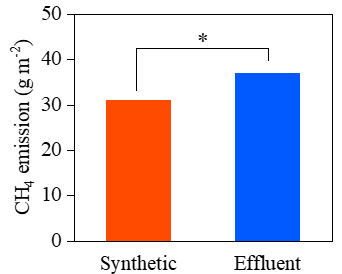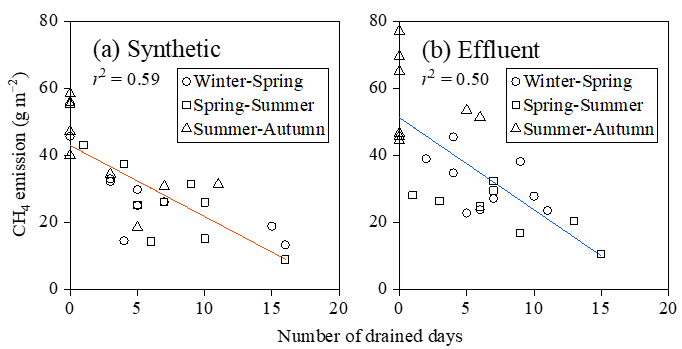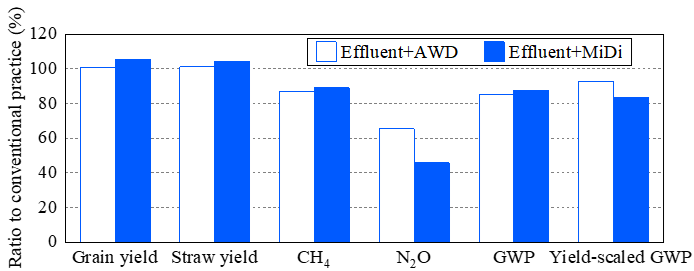Multiple drainage can cancel out the enhancement of methane emission by biogas effluent application in a rice paddy
Description
Household biogas production from livestock manure and its domestic use in cooking and heating is popular in Vietnam. However, the discharge of untreated biogas effluent (also known as methane fermentation digestate) containing plant nutrients, including nitrogen, into rivers causes local environmental problems such as water pollution. To address this issue, the biogas effluent was used as organic fertilizer for rice, the locally dominant crop, and was found to be effective (2019 Research Highlights article entitled “Variable-timing, fixed-rate application of cattle biogas effluent as fertilizer for rice using a leaf color chart”). However, because biogas effluent also contains labile organic carbon, which is a substrate for microbial production of methane (CH4), a potent greenhouse gas (GHG), its application to a paddy field may enhance CH4 emission from the flooded soil. Here we hypothesized that combining multiple drainage with biogas effluent application can cancel out the CH4 enhancement, and tested this by observing a farmer’s paddy field with triple rice cropping in the Mekong Delta, Vietnam.
Chemical properties, including organic matter content, of the biogas effluent produced from cattle manure varied among rice seasons, and the application of cattle biogas effluent increased CH4 emission by 19% on average as compared to synthetic fertilizer application (Fig. 1). We tested two multiple drainage practices: alternate wetting and drying (AWD), which is a water-depth-dependent irrigation method; and midseason drainage followed by intermittent irrigation (MiDi), which is a day-number-dependent irrigation method. Although the lowland location made it difficult to naturally drain flooded surface water, both AWD and MiDi reduced CH4 emission in proportion to the increase in the number of drained days between crop establishment and final drainage in each rice season (Fig. 2). As a result, the proposed combination practices reduced CH4 emission by 11–13% and nitrous oxide (N2O), another potent GHG, emission by 35–54% without loss of grain and straw yields as compared to the conventional practice with synthetic fertilizer application and continuous flooding (Fig. 3). The Global Warming Potential (GWP), carbon dioxide (CO2)-equivalent of combined CH4 and N2O emissions, and grain-yield-scaled GWP were also reduced by the proposed combination practices.
The results indicate that the proposed combination practice (i.e., multiple drainage with biogas effluent application) can be applied to the rice-producing areas using livestock biogas effluent as organic fertilizer. It is likely that multiple drainage can further reduce CH4 emission in case of a field location under better drainage conditions.
Figure, table
-
Fig. 1. CH4 emissions from synthetic fertilizer application and biogas effluent application
Statistically significant difference at p < 0.05 by ANOVA. -
Fig. 2. Relationships between CH4 emission and the number of drained days between crop establishment and final drainage in each rice season for (a) synthetic fertilizer application and (b) biogas effluent application
-
Fig. 3. Comparisons between the proposed combination practices, biogas effluent application with AWD or MiDi, and the conventional practice with synthetic fertilizer application and continuous flooding
Figures reprinted/modified with permission from Minamikawa et al. (2021).
- Classification
-
Research
- Research project
- Program name
- Term of research
-
FY 2019–2021
- Responsible researcher
-
Minamikawa Kazunori ( Crop, Livestock and Environment Division )
Uno Kenichi ( Rural Development Division )
Huynh Cong Khanh ( Can Tho University )
Tran Sy Nam ( Can Tho University )
Nguyen Huu Chiem ( Can Tho University )
- ほか
- Publication, etc.
-
Minamikawa K et al. (2021) Agriculture, Ecosystems and Environment 319: 107568https://doi.org/10.1016/j.agee.2021.107568
- Japanese PDF
-
2021_A01_ja.pdf357.49 KB
- English PDF
-
2021_A01_en.pdf223.94 KB
- Poster PDF
-
2021_A01_poster.pdf219.77 KB
* Affiliation at the time of implementation of the study.



